
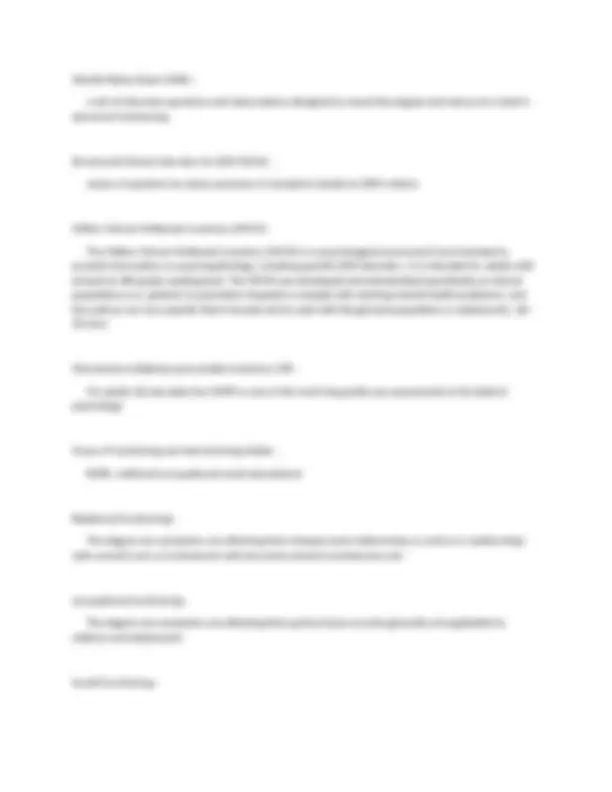
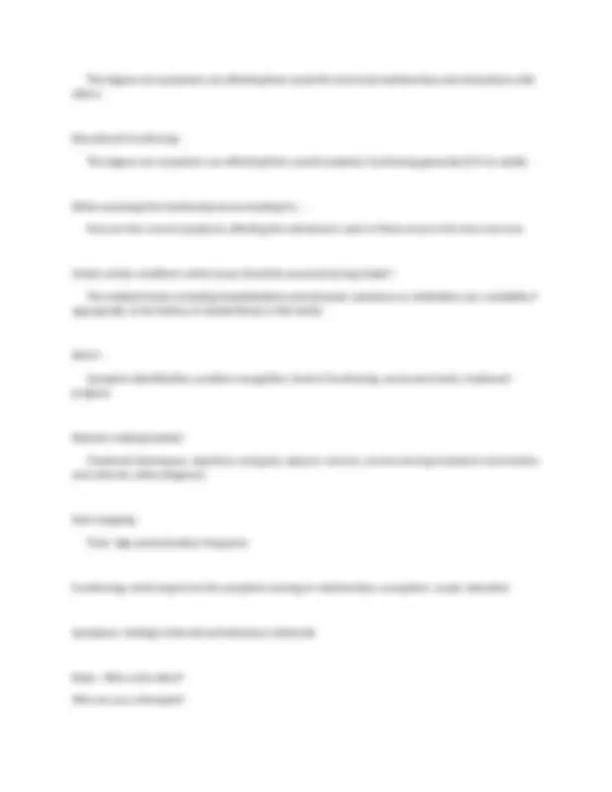
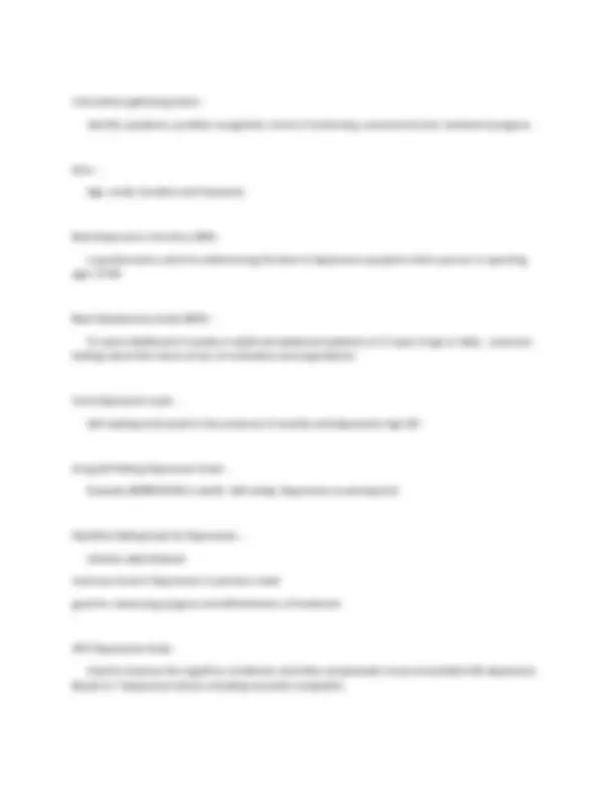
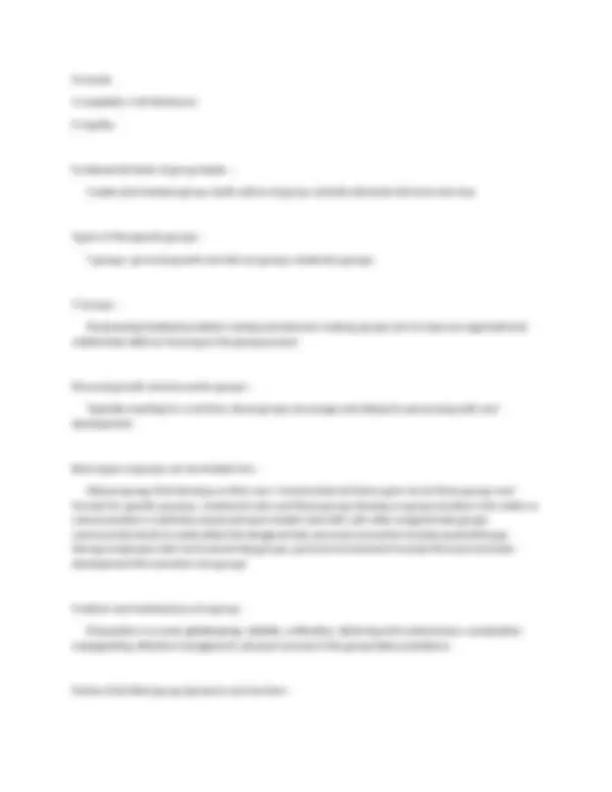
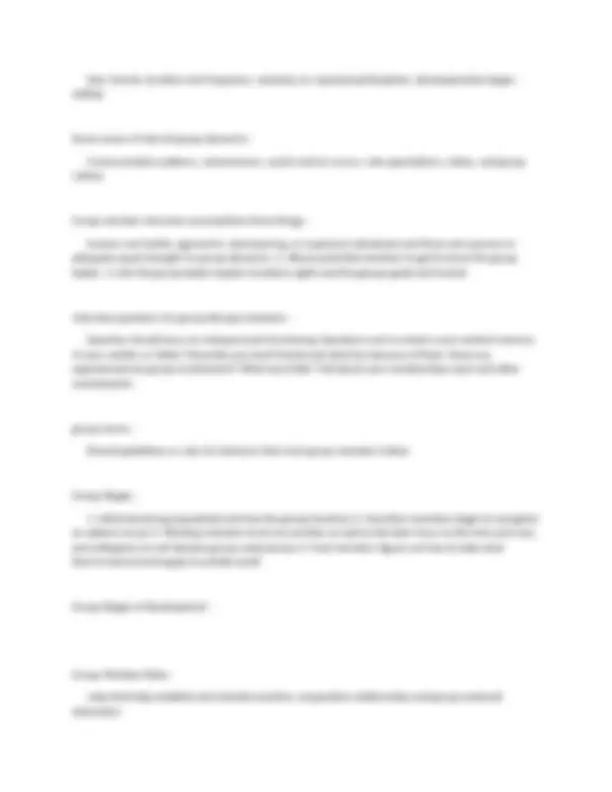
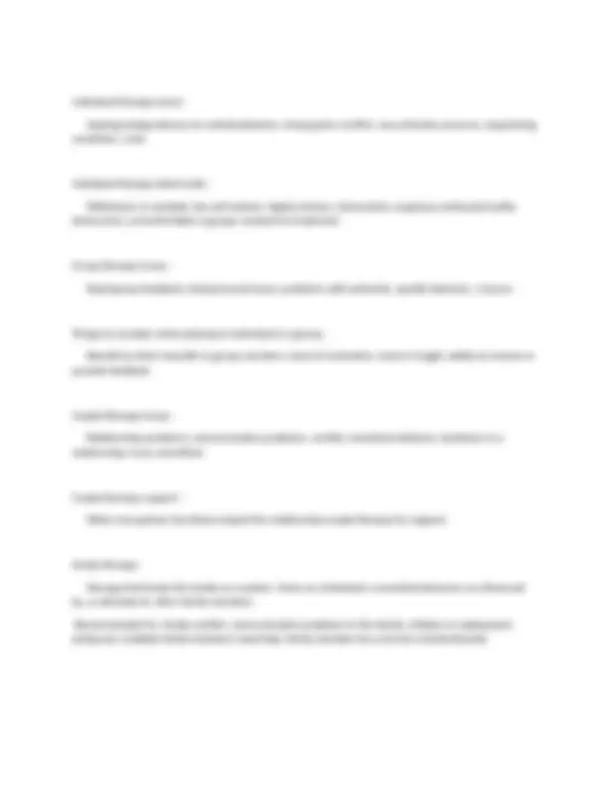


Study with the several resources on Docsity

Earn points by helping other students or get them with a premium plan


Prepare for your exams
Study with the several resources on Docsity

Earn points to download
Earn points by helping other students or get them with a premium plan
Community
Ask the community for help and clear up your study doubts
Discover the best universities in your country according to Docsity users
Free resources
Download our free guides on studying techniques, anxiety management strategies, and thesis advice from Docsity tutors
Study hints for the NCMHCE exam. It covers various treatment modalities for children, adolescents, and adults. It also includes assessments for children and adolescents with behavioral issues, as well as tools for measuring depression and intelligence. The document also discusses the CHARM core conditions of group leader. useful for students preparing for the NCMHCE exam or for those studying counseling and psychology.
Typology: Exams
1 / 10

This page cannot be seen from the preview
Don't miss anything!







Treatment modalities - individual, group, and family counseling, support groups, lifestyle changes, education and aftercare Which treatment modality is best for children? - Family therapy When treating an adolescent which modality is best to use? - For behavioral issues family therapy; non-behavioral issues is case by case but more times than not still family What treatment modalities do you use with adults? - Non-substance related disorders is individual therapy, adults with substance-abuse issue is group therapy, adults with relational problems is couple therapy Unless directed which type of therapy is best used with children? - Behavior therapy When working with adolescents, which theoretical orientation is best use if not directed otherwise? - Behavioral issues behavior therapy, non-behavior issues CBT The theoretical orientations that works best with adults unless specifically directed include - For substance related disorders Person centered therapy and motivational interviewing, in general CBT For children and adolescents with behavioral issues the five assessments that are virtually interchangeable with each having a parent version or teacher version except noted include.. -
One child behavior checklist, 2 Vanderbilt diagnostic rating scale, 3 conners rating scales revised, 4 BASC or the behavior assessment system for children, 5 DISC4 with a Columbia diagnostic interview scheduled for children DISC -P for parents DISC -Y for youth Child Behavior Checklist (CBCL) - Tool used for minors 4-18. Investigates behavior problems among childhood to address the issues of social competency and behavior. 138 items. Vanderbilt diagnostic rating scales - Ages 6 to 12 years for parent and teacher Conner's Rating Scales- Revised - Scales used to evaluate problem behavior in youth ages 3 through 17. Includes scales completed by parents and teachers and an adolescent self-report scale for clients ages 12 through 17. BASC - Behavior Assessment System for Children - To understand behaviors & emotions of children & adolescents 2yrs-College teacher & parent rating scales 6yrs-College self-report what are the three Columbia diagnostic interview scheduled? - DISCfor is for children DISC-p is for parents 6 to 17 years and DISC-Yis for youth 9 to 17 years Millon adolescence clinical inventory MACI - For teenagers 13 to 19 years of age intended specifically for clinical populations Minnesota Multiphasic Personality Inventory (MMPI) - widely used structured personality test designed to assess symptoms of mental disorders, Measurement of personality, behavioral issues,and psychopathology
The degree one symptoms are affecting their social life and social relationships and interactions with others Educational functioning - The degree one symptoms are affecting their overall academic functioning generally N/A for adults When assessing the functioning we are looking for... - How are the current symptoms affecting the individual in each of these areas in the here and now. Under certain conditions which areas should be assessed during intake? - The medical history including hospitalizations,last physical, substance or medication use, suicidality if appropriate, & the history of mental illness in the family SPLAT - Symptom identification, problem recognition, level of functioning, assessment tools, treatment progress Decision making toasted - Treatment techniques, objectives and goals, adjunct, services, services during treatment, termination and referrals, ethics,diagnosis Sims mapping - Time -Age,onset,duration frequency Functioning- what impact are the symptoms having on relationships, occupation, social, education Symptoms- feelings (internal) and behaviors (external) Roles - Who is the client? Who are you a therapist?
Information gathering basics - Identify symptoms, problem recognition, level of functioning, assessment tools, treatment progress time - Age, onset, duration and frequency Back Depression Inventory (BDI) - a questionnaire useful for determining the level of depressive symptoms that a person is reporting, ages 13- Beck Hopelessness Scale (BHS) - To assess likelihood of suicide in adult and adolescent patients of 17 years if age or older., measures feelings about the future of loss of motivation and expectations Carol depression scale - Self reading instrument in the presence of severity and depression Age 18+ Zung Self-Rating Depression Scale - Evaluate DEPRESSION in adults. Self-rating. Depression-screening tool. Hamilton Rating Scale for Depression - clinician administered measures level of depression in previous week good for measuring progress and effectiveness of treatment IPAT Depression Scale - Used to measure the cognitive, emotional, and other symptomatic issues associated with depression. Based on 7 depression factors including somantic complaints.
an intelligence test that measures children's ability to integrate different stimuli simultaneously and step-by-step thinking Wessler intelligence scale for children - Generate a full-scale IQ that represents a child general intellectual ability; 6- Wessler adult intelligence scale - Measures cognitive ability in adults; focus is on for domains of intelligence verbal comprehension perceptual reasoning working memory and processing speed; 16+ Detroit test of learning attitude - Measures of both general intelligence and discrete ability areas: also shows the effects of language, attension, and motor abilities on test performance ages, 6 to 17 Raven's Progressive Matrices - an intelligence test that emphasizes problems that are intended not to be bound to a particular language or culture; person asked to identify the missing element that completes a pattern Leiter International Performance Scale, Revised (Leiter-3) - Ages 3 to 75, nonverbal measure of intelligence; game-like tasks assesses positive attentional and neuropsychological abilities Stanford Binet intelligent test - Ages 2+; cognitive ability assessment used to measure intelligence, helpful in assessing neurological issues; test results can also be helpful in classroom placement Slosson Intelligence Test - Provides quick evaluation of general verbal cognitive ability. INDEX OF VERBAL INTELLIGENCE.; 4- CHARM - core conditions of group leader - C harm
H onesty A cceptable. S elf-disclosure E mpathy Fundamental tasks of group leader - Create and maintain group, build culture of group, activate eliminate the here and now Types of therapeutic groups - T groups, personal growth and Kat are groups, leaderless groups T-Groups - Emphasizing feedback problem-solving and decision-making, groups aim to improve organizational relationship skills by focusing on the group process Personal growth and encounter groups - Typically meeting for a set time, these groups encourage risk taking for personal growth and development. Basic types of groups can be divided into - Natural groups that develop on their own; formed external factors give rise to these groups and formed for specific purpose,; treatment roles and these groups develop as group members into relate so communication is relatively casual and open ended; task with rolls often assigned task groups communicate tends to really affect the designed task, personal connection include psychotherapy therapy employee relief and mutual help groups; personal enchantment include Personal and team development life transition into groups Creation and maintenance of a group - Preparation is crucial, gatekeeping, stability, unification, deterring anti-cohesiveness, socialization scapegoating, affective management, physical survival of the group takes presidence Factors that affect group dynamics and function -
Individual therapy issues - Seeking independence for individualization, intrapsychic conflict, very intimate concerns, long lasting conditions, crisis Individual therapy client traits - Withdrawn or isolated, low self-esteem, highly anxious, introverted, suspicious antisocial hostile destructive, uncomfortable in groups resistant to treatment Group therapy issues - Need group feedback, interpersonal issues, problems with authority, specific behavior,, trauma Things to consider when placing an individual in a group - Benefit to client, benefits to group members, level of motivation, level of insight, ability to receive or provide feedback Couple therapy issues - Relationship problems, communication problems, conflict, emotional distance, loneliness in a relationship, trust, and affairs Couple therapy support - When one partner has illness impact the relationship couple therapy for support family therapy - therapy that treats the family as a system. Views an individual's unwanted behaviors as influenced by, or directed at, other family members Recommended for: family conflict, communication problems in the family, children or adolescents acting out, multiple family members need help, family member has a chronic mental disorder